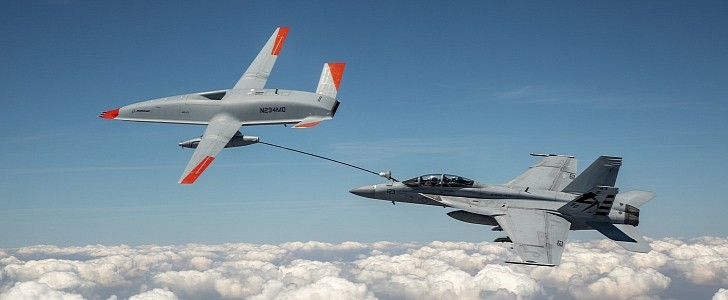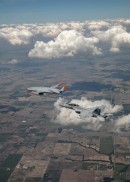History was made on June 4th when an unmanned aircraft successfully refueled another aircraft mid-flight. To demonstrate air-to-air refueling, the U.S. Navy and Boeing used an MQ-25 Stingray to assume the carrier-based tanking role for the test flight.
The MQ-25 T1 test asset had successfully demonstrated its aerial refueling capability when it extended the hose and drogue mid-flight from its aerial refueling storage (ARS). After that, it safely transferred jet fuel to a U.S. Navy F/A-18 Super Hornet.
Prior to refueling, the F/A-18 test pilot flew in tight formation behind the MQ-25 to ensure performance and stability. This maneuver required a 20 feet (6 meters) gap between the unmanned aircraft and the F/A-18 Super Hornet.
According to Boeing, the aircraft were flying at operationally reasonable speeds and altitudes. After the assessment was successfully accomplished, the MQ-25's drogue was extended, and the F/A-18 pilot moved closer to connect with the unmanned aircraft and accept refueling.
This achievement follows 25 T1 flights in which both the aircraft and the ARS aerodynamics were tested over the flight envelope. Plus, U.S. Navy also used MQ-25 digital models to simulate aerial refueling. The unmanned aircraft will continue test flights before being delivered to Norfolk, Virginia. Later this year it will be used for deck handling trials aboard a U.S. Navy carrier.
The MQ-25 T1 test asset is an unmanned tanker aircraft being developed as part of a program for the U.S. Navy, and it is a forerunner of the seven test aircraft Boeing is producing under a contract awarded in 2018. The drone will take over the carrier-based tanking job currently done by F/A-18s, allowing for more effective use of the combat strike jets and extending the range of the carrier air wing.
"Over the next few years, we will work side-by-side with Boeing to deliver this capability that will greatly enhance the future carrier air wing.", notes Rear Admiral Brian Corey, who commands the Program Executive Office for Unmanned Aviation and Strike Weapons (PEO U&W).
Prior to refueling, the F/A-18 test pilot flew in tight formation behind the MQ-25 to ensure performance and stability. This maneuver required a 20 feet (6 meters) gap between the unmanned aircraft and the F/A-18 Super Hornet.
According to Boeing, the aircraft were flying at operationally reasonable speeds and altitudes. After the assessment was successfully accomplished, the MQ-25's drogue was extended, and the F/A-18 pilot moved closer to connect with the unmanned aircraft and accept refueling.
This achievement follows 25 T1 flights in which both the aircraft and the ARS aerodynamics were tested over the flight envelope. Plus, U.S. Navy also used MQ-25 digital models to simulate aerial refueling. The unmanned aircraft will continue test flights before being delivered to Norfolk, Virginia. Later this year it will be used for deck handling trials aboard a U.S. Navy carrier.
The MQ-25 T1 test asset is an unmanned tanker aircraft being developed as part of a program for the U.S. Navy, and it is a forerunner of the seven test aircraft Boeing is producing under a contract awarded in 2018. The drone will take over the carrier-based tanking job currently done by F/A-18s, allowing for more effective use of the combat strike jets and extending the range of the carrier air wing.
"Over the next few years, we will work side-by-side with Boeing to deliver this capability that will greatly enhance the future carrier air wing.", notes Rear Admiral Brian Corey, who commands the Program Executive Office for Unmanned Aviation and Strike Weapons (PEO U&W).




